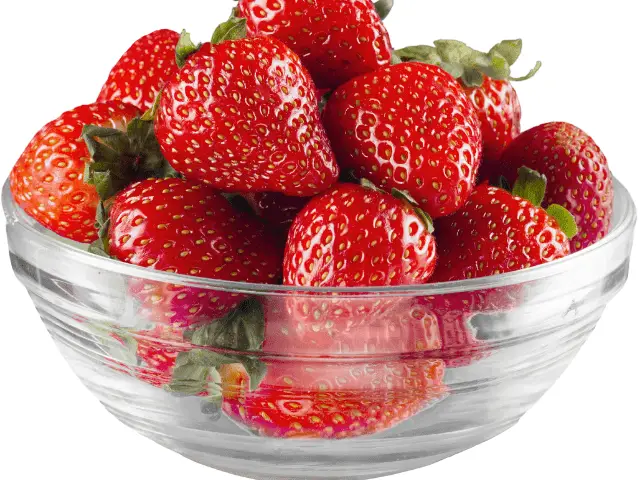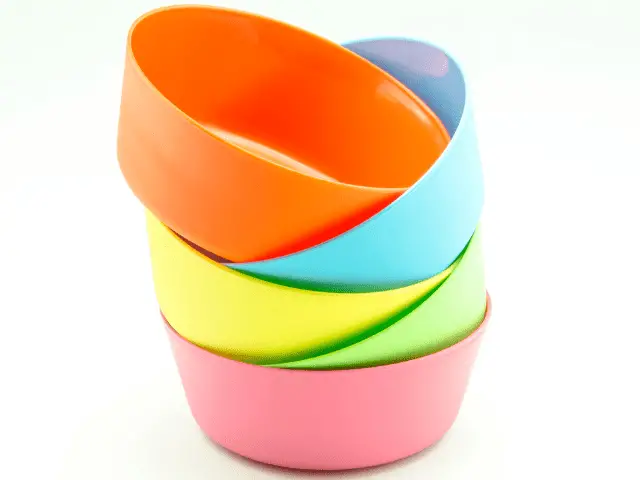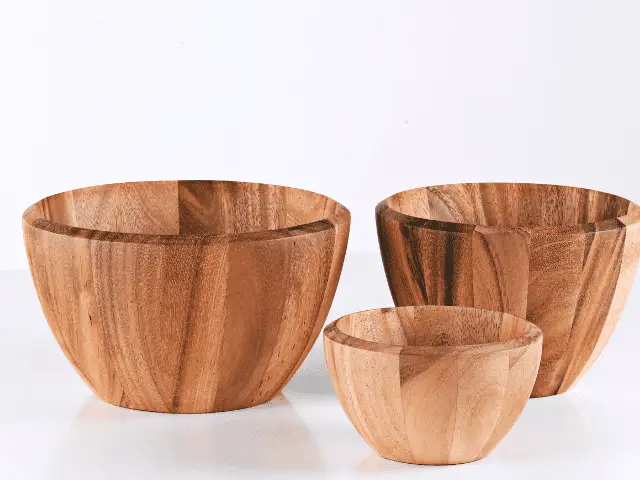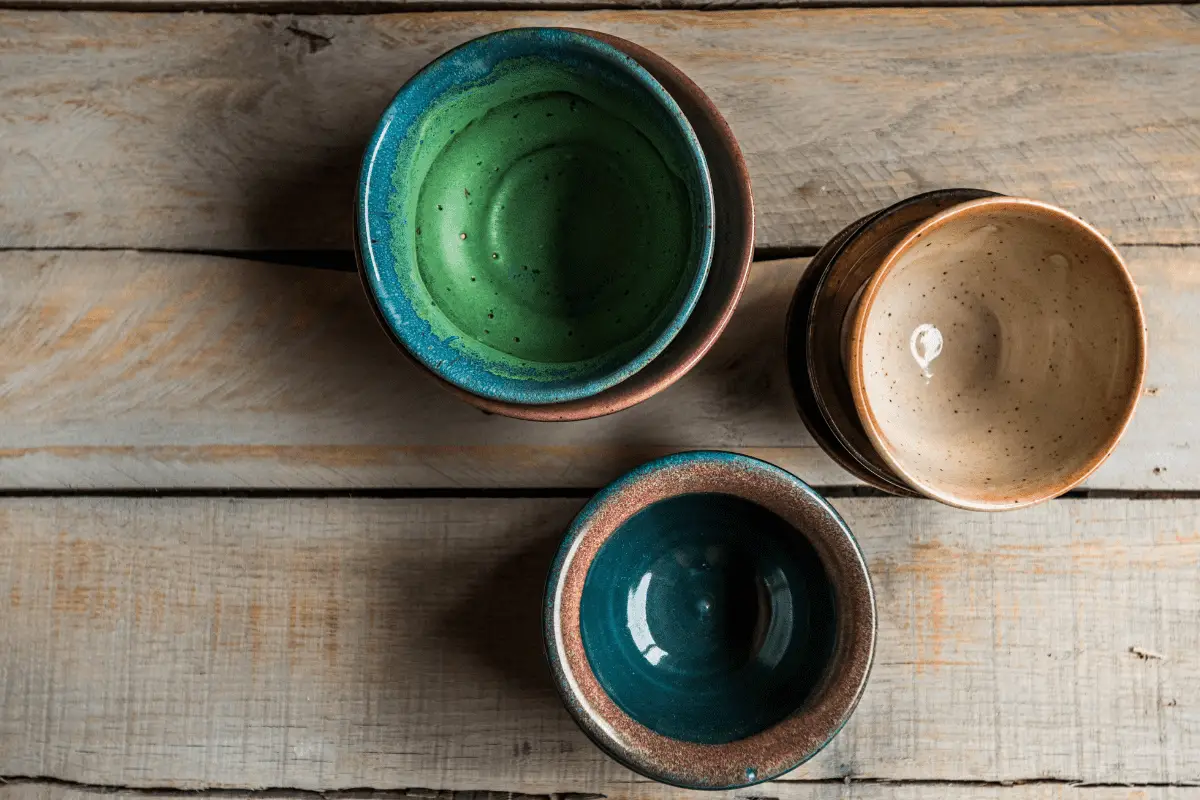Bowls are simple objects you’ll find in just about any household. They come in many different sizes, colors, and materials. Most also can be stacked or nested for storage or transit.
So it isn’t hard to pack bowls—even though keeping some of them, like ceramic and glass bowls, intact can be tricky. There are ways to prepare all types of bowls for moving, as we’ll explain here.
Let’s begin by looking at the various materials commonly used in making bowls.
Table of Contents
Common Bowl Materials
A bowl’s material can affect its use—and vice versa.
For example, earthenware bowls are only recommended for cooking under certain conditions. And while flexible silicone mixing bowls work great, their floppiness takes some getting used to.
That’s why mixed bowl collections are so widespread and often seen on moving trucks. People seldom want to part with any of them.
Pyrex® and Regular Glass Bowls

The primary difference between regular glass and Pyrex is that the latter is stronger, more fire-resistant, and shatterproof. So it can withstand higher temperature fluctuations compared to ordinary glass.
However, since Pyrex will sometimes chip, crack, or (rarely) shatter, it’s best to pack it as you would any glass bowl.
If your glass bowls nest inside one another, place buffering material (e.g., bubble wrap, flexible corrugated cardboard, or small towels between each bowl and the next.
Cover the bottom of a double-walled moving box with rags, crumpled newspaper, or biodegradable packing peanuts. Load the prepared bowls and buffer any remaining space. Be sure the top is cushioned well too.
If the bowls are the same size and stackable but don’t nest, wrap them individually in packing paper, and again using one of the buffering materials mentioned above, stack three together, wrap the sets, and place them in a single layer of rows.
Then, surround all the stacks with more shock-absorbent material, ensuring no two stacks are touching. And in all cases, don’t forget the “Fragile” labels!
Ceramic Bowls
Most ceramic bowls are stoneware, earthenware, fine china, and bone china. You can find ceramic bowls in the kitchen or other spots around the house. Often created by artists using a pottery wheel, some ceramic bowls are cherished keepsakes.
These bowls are usually fragile and irreplaceable!
Unlike glassware, broken pottery can sometimes be salvaged—especially if it cracks in an “S pattern.”
However, provided you have all the broken shards, you can use a strong adhesive to glue them back together. You might not be able to put them in the dishwasher after gluing, but you probably should be handwashing your ceramics anyway.
Metal Bowls
Whether stainless steel, aluminum, copper, or something else, metal bowls generally hold up well during a move unless they get dinged. But there is a much lower chance of that happening than breaking a glass or ceramic bowl.
Since a metal bowl set is a kitchen standard, they are pretty sturdy, especially stainless steel ones.
Bowls made of coated metal (e.g., enamel-coated steel) are rare (though coatings often are used in cookware). If you have coated bowls, be sure to cover them, inside and out, to avoid chipping and scratching.
Plastic Bowls

Like metal bowls, plastic bowls also hold up well during moving. But since they easily bend, scratch, or warp, you should wrap them as you would metal bowls. Plastic bowls are inexpensive and easy to replace, so just be sure you’re buying a safe, food-grade plastic.
Silicone Bowls
Although we withhold judgment on claims that silicone, a polymer, leach toxins into food, we know it’s probably the hardest to damage out of all bowl materials discussed here. It’s sometimes called silicone rubber because of its resilience and ability to bend as needed for pouring, etc.
So, if you’re moving silicone bowls, you can pack them pretty much however and wherever you want. You can even use them to encase and protect smaller, more delicate bowls.
Wood Bowls

Most wood bowls are either decorative, often unique craft creations, or used to serve food (e.g., salad bowls).
However, as with wood cutting boards, you should not use wood bowls to prepare raw food ingredients. Wood is porous and harbors dangerous germs. So if you’ve been using a wood bowl for food preparation, throw it away.
Don’t pack it for further use!
On the other hand, treat your wood serving and decorative bowls as the treasures they are. Turning wood on a lathe is a distinct talent, and even factory-made wood bowls have unique and irreplicable patterns and designs. So wrap and pack them as you would ceramics.
Wood bowls probably won’t break in transit, but they could incur permanent damage from dings and scratches.
Bamboo Bowls
Do you know that bamboo offers the following benefits, which you’ll find in its products?
- Bamboo is plentiful and renewable.
- It’s biodegradable and can be composted
- And it converts 35% more carbon dioxide into oxygen than trees do.
Bamboo bowls are also 100% natural, food-safe, and sturdy (with greater tensile strength than steel). So you can be confident knowing that, when wrapped and boxed, they’ll hold up exceptionally well during your move.
And on the rare chance that your bamboo bowls are severely damaged or destroyed while moving, throw them away. They’ll degrade in a few months, which helps grow new bamboo. Thus, there will be more sustainable products in an ongoing replenishment cycle.
Have We Bowled You Over With New Insight?
Of course, you’ll want to know that your bowl collection arrived safe and sound following the move. So make the box(es) holding them among the first you unpack. That way, you’ll know that they arrived safe and sound. Plus, bowls have many uses in a new home.
For example, you can place them near unpacked boxes to hold stray items you uncover while unpacking. Small toys, hardware, guitar picks, fridge magnets, etc., inevitably appear while unboxing after a move.
Once you’ve settled in, return these small items to their proper places and re-enlist the bowls for food prep, home décor, or other uses.
Find this article helpful? We also have lots of tips for how to pack your entire kitchen.


